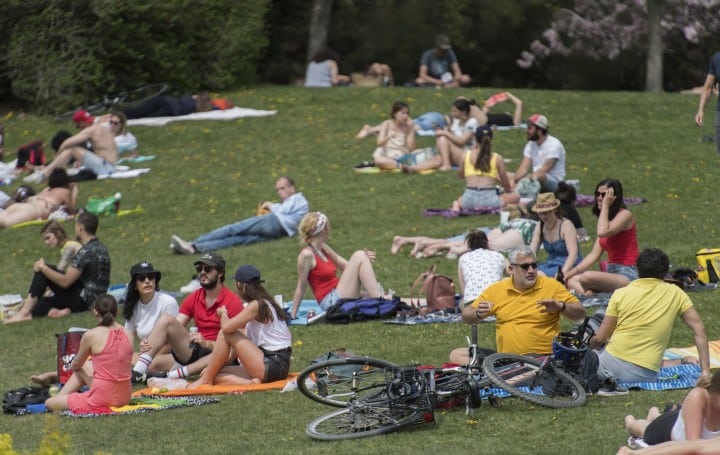Heat wave forces cities, long-term care centres to rethink how to offer heat relief under COVID-19
Published May 26, 2020 at 9:12 pm

OTTAWA — A heat wave engulfing large swaths of Ontario and Quebec could spell tragedy for the people who are already most at risk from COVID-19, health experts warn.
Environment Canada issued a heat warnings this week for much of southern and eastern Ontario, as well as special weather statements related to heat for parts of the province and most of Quebec.
Like COVID-19, rising summer temperatures are most dangerous for seniors and people with underlying health conditions but, unlike past summers, many of those people won’t be able to fall back on the relief of air-conditioned malls, libraries or recreation centres. Movie theatres that offer cool darkness in addition to fun flicks are closed. Splash pads and wading pools that usually open in late spring are dry.
“This could lead to a huge wave of excess deaths around something that was completely preventable,” said Dr. Samir Sinha, director of geriatrics for Sinai Health System in Toronto.
In Quebec, two-thirds of long-term care residents are without air conditioning in their rooms, he said — as many as 28,000 residents.
Typically homes deal with summer heat by gathering people together in air-conditioned spaces, but that’s not possible when residents, who are particularly at risk of dying from COVID-19, need to be kept apart.
Canada’s deputy chief public officer Dr. Howard Njoo suggested Tuesday that long-term care homes should set up fans and take residents outdoors in shifts to maintain physical distancing.
But this is a problem that governments should have seen coming, Sinha said.
After more than 90 deaths were linked to the sweltering 2018 heat wave in Quebec, mostly among older people and people with underlying health conditions, he said little has been done to turn down the heat in long-term care.
Balancing the need for heat relief with measures to limit the spread of the novel coronavirus will be a challenge for municipalities as scorching temperatures engulf a stretch of central Canada, the country’s chief public health officer said Tuesday.
While some indoor and outdoor spaces that are currently shuttered due to the pandemic can be opened up to help residents cool down, ensuring compliance with physical distancing and other health measures is key, Dr. Theresa Tam said.
“All of those measures will still apply, unfortunately, so that would be one aspect of it that people will have to respect,” Tam said.
Minimizing the risk of COVID-19 transmission is easier outdoors, but problems arise when people need to use communal spaces such as restrooms, which municipalities must take into consideration, Tam said.
“So the numbers of people that can be accommodated may not be necessarily due to the restrictions of that open space but due to … access to these common services so they will have their specific plans to deal with that,” she said.
Meanwhile seniors who live independently who may be without air conditioning and unwilling to leave their homes to find cooler spaces for fear of putting themselves at risk of contracting the virus, Sinha said.
“Seniors are really left with really limited options,” he said.
The kind of isolation COVID-19 demands might also mean people who develop dehydration or other heat-related health emergencies might not have the support they need, said Dr. Sandy Buchman, president of the Canadian Medical Association.
That’s why air conditioning is so important, as are social supports for vulnerable people living alone, he said.
Cooling centres with adequate physical distancing measures will also be vital.
“They need it or we’re going to see people succumb to this,” Buchman said.
In Toronto, where hundreds of such spaces were identified as a heat relief network last year, officials said they were opening six emergency cooling centres across the city.
The six centres have a total combined capacity of about 580 people, or one person for every four square metres. A spokesman for the city said mobile cooling will be available via city buses that will be on standby if the centres reach capacity.
Brad Ross said attendance at the cooling centres was low in the first few hours after they opened their doors Tuesday. But he said the city is looking to open additional locations and expand hours of operation as the spring and summer go on.
“There would have been, in the before times, far more options available to people but clearly with COVID-19, many public spaces are closed,” he said.
“We are looking at what other options… we have available to us. Because obviously this is only the end of May, and we’ve got three more months at least of summer ahead of us.”
The city said centres are meant as a “last resort” for residents who don’t have access to cool spaces, adding strict infection prevention and control protocols are in place.
The City of Ottawa is opening four cooling centres in community centres from Tuesday to Thursday, asking people who visit them to wear cloth masks. They’re set up to allow physical distancing and will include washrooms and access to water, the city said in a news release.
Two cooling centres have been opened in London, Ont., one at the Canada Games Aquatic Centre and another at the South London Community Centre, the city said in a tweet.
Hamilton’s central library branch was also set to open Tuesday afternoon and into the evening, and again on Wednesday. However, “library materials and services are not available,” the library tweeted.
Officials in Kitchener, Ont., tweeted that the city is working with local health authorities to find cooling centre options and will share more details when possible.
Paola Loriggio and Laura Osman, The Canadian Press
insauga's Editorial Standards and Policies advertising





